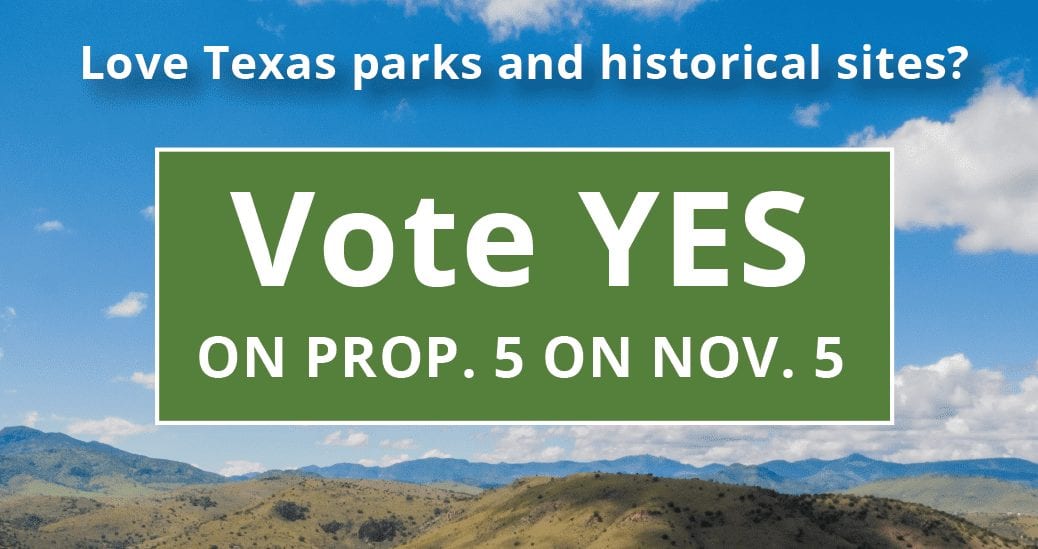
Return to October 2019 newsletter
Texans will go to the polls on Nov. 5, or during early voting starting Oct. 21, to cast a vote on 10 proposed amendments to the Texas Constitution. One of those is Proposition 5, which would dedicate revenue from the sporting goods sales tax for use only by the Texas Parks and Wildlife Department and the Texas Historical Commission for public parks and historic sites. The op/ed below explains the proposition. More information can be found from the Texas Coalition for State Parks.
Vote in November to fund our state parks for future generations of Texans
By State Sen. Lois Kolkhorst and Rep. John Cyrier
Some of our families’ best summer adventures over the years have been at Texas’ state parks. And the numbers indicate that you and your family have probably enjoyed our parks and historic sites over the years, too: Nearly 10 million people visited state parks in 2017, up about 40 percent since 2012.
Texas is growing quickly. More people are visiting the parks than ever before, and we couldn’t be happier about it. However, this puts pressure on already-strained park infrastructure, much of which is ailing.
Altogether, our state parks sit on about 640,000 acres of land, much of which was first developed by the Civilian Conservation Corps in the 1930s and ’40s. In the decades that followed, the infrastructure – roads, marinas, campgrounds, swimming pools, utility systems, sewage treatment, you name it – simply hasn’t kept up with 21st century demands.
For example, 91 percent of the 113 playgrounds are 30 years old or older, and 50 of those are in urgent need of replacement. And 90 percent of the 491 restroom facilities in the parks are over 30 years old, with 300 needing to be removed or replaced.
Now there’s something on which the Texas Legislature should take action, don’t you think?
We sure thought so. We love Texas’ state parks and want to preserve them for future generations of Texans to love and enjoy, too. And that’s why we worked hard this year to pass bipartisan legislation that would amend the Texas Constitution accordingly.
The next and final step is to put the issue before Texas voters in this November’s election. It’ll be Proposition 5 on the ballot.
Proposition 5 is a constitutional dedication of revenue from the existing sales tax so that those dollars can be used only by the Texas Parks and Wildlife Department and the Texas Historical Commission to maintain public parks and historic sites, and not for any other purposes. (From 1993 to 2017, the state collected nearly $2.5 billion in revenue from the sporting goods sales tax, yet only 40 percent was appropriated for parks, with the rest used to fill in gaps elsewhere in the state budget.)
A yes vote on Proposition 5 on Nov. 5 will protect our natural areas and historic sites so that we don’t lose the very things that make Texas such a special place to live.
Make no mistake: Sustainable, consistent funding is the fiscally conservative and economically sound way to ensure our parks endure for years and years to come.
One very important thing to note: Proposition 5 results in no new taxes. None. Not now, not in the future. The taxes that businesses pay will not increase, nor will the sales taxes of individual Texans increase. One of the things that makes Texas such a great place to live and work is the low tax burden that drives growth and keeps government small. As fiscal conservatives, we believe we can achieve our goals and invest in what’s important simply by being smarter and more responsible with the state revenue that we already have.
Think of it as putting a little more truth in our taxation.
The Legislature has done its part, and so now the measure goes to the people. Surely we can all agree that these special places are vital to our economy and to our Texas heritage, culture and way of life.
Lois Kolkhorst is a Republican representing Brenham in the Texas Senate. John Cyrier is a Republican representing Lockhart in the Texas House.
Note: The above op/ed was first published in the Dallas Morning News and is reprinted here with the permission of the Texas Coalition for State Parks.